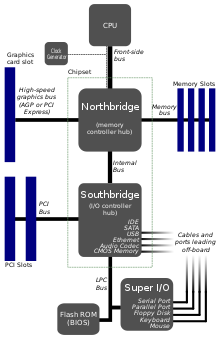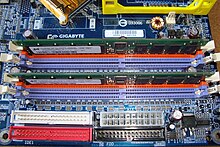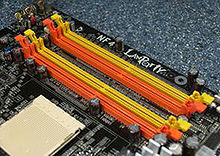Dual channel

As a Dual Channel is called an architecture in the computer technology , with the two (or more) memory modules on a processor can be operated in parallel. For this, separate data buses are used from the processor (CPU) or memory controller to the individual modules. The simultaneous transmission over several buses means that more data can be transmitted per unit of time. This technology has been used in personal computers since the early 2000s .
Distinction
Depending on the location of the storage controller, a distinction can be made between two basic approaches:
- With the classic chipset architecture, the memory controller is located in the northbridge (part of the chipset). This in turn is coupled to the CPU via the front side bus . When operating in dual-channel mode, the bandwidth between CPU and memory is not increased, but only the bandwidth between northbridge and memory. The performance gain that can be achieved through the increased memory bandwidth is correspondingly low (see below). This technique is based in principle on memory interleaving .
- If the memory controller is located directly in the main processor (at AMD, for example, since the introduction of the Athlon 64 ), the bit width of the memory bus (data bus) and thus the theoretically available memory bandwidth is doubled. In the case of X86 processors , the 64-bit wide data bus that has existed since the Intel Pentium (previously 32-bit for the 80486 ) is increased to 128 bits. For example, the dual-channel capability of the Athlon 64 depends on the CPU - more precisely on the socket used - and not on the chipset on the motherboard . Most AMD processors since socket 939 therefore support dual-channel operation. The additional pins compared to socket 754 form the necessary second memory bus.
conditions
No special modules are required for operation - only the memory controller must support this technology. The modules used do not necessarily have to be identical. Dual Channel works with any type of memory as long as the size of the memory is identical in both channels.
Memory usage examples
It should be noted that the physical distribution of the slots and the permitted configurations depend on the chipset, mainboard and sometimes also on the modules used. The necessary information is usually in the manual and in the Qualified Vendor List (QVL) of the mainboard.
example 1

One 512MB module per memory channel:
| Slot 1 | 512 MB |
|---|---|
| Slot 2 | unoccupied |
| Slot 1 | 512 MB |
|---|---|
| Slot 2 | unoccupied |
Example 2
Two 1 GB modules per memory channel:
| Slot 1 | 1 GB |
|---|---|
| Slot 2 | 1 GB |
| Slot 1 | 1 GB |
|---|---|
| Slot 2 | 1 GB |
Example 3
Dual-channel also works with two differently sized modules per channel, for example 512 MB and 1 GB per channel, then a total of 3 GB:
| Slot 1 | 1 GB |
|---|---|
| Slot 2 | 512 MB |
| Slot 1 | 1 GB |
|---|---|
| Slot 2 | 512 MB |
Example 4
If there is the same amount of memory on both memory channels, but in a different number of modules, Dual Channel only works with certain chipsets:
| Slot 1 | 512 MB |
|---|---|
| Slot 2 | 512 MB |
| Slot 1 | 1 GB |
|---|---|
| Slot 2 | unoccupied |
Further requirements
The stability and speed of dual-channel can be improved, for example, by:
- Same organization of the memory chips. This can often, but not always, be determined by the number of chips or the populated sides of the DIMM . Different organization is a common reason for incompatibilities.
- The two modules operate at the same speed, otherwise the slowest module determines the speed.
- The same memory module manufacturer and model, is often sold as a dual-channel package at an additional cost.
- With some chipsets, dual channel only works if a certain total number of ranks is not exceeded (the number of ranks of the individual modules is added). This is particularly relevant when all slots are occupied.
Since these requirements are met by many manufacturers, modules from different manufacturers can also be combined.
There is a special feature with some chipsets, such as nForce2 or SiS 655; these can also operate three modules in dual-channel mode. The first two DIMM sockets can be combined with the third. The capacities of the modules must match, otherwise (i.e. if the storage capacity of the third module is higher or lower than that of the first two) the remaining main memory is operated in single-channel mode. With current Intel chipsets it is also irrelevant whether the capacities of the memory modules in both memory controller channels match (see section Dual Channel Asymmetric ).
power
In contrast to the single-channel mode, in which the data bus is 64 bits wide (i.e. 64 data lines), in the dual-channel mode two modules are operated simultaneously with a 64-bit data bus each. Since the clock rate at which the memory is operated remains the same, but the amount of data transferred per clock doubles (i.e. 128 bits per clock instead of the previous 64 bits), the use of dual-channel mode theoretically doubles the memory throughput. For example, PC2-6400 memory can transfer approx. 6.4 gigabytes / s of data to the memory controller in single-channel mode, and approx. 12.8 gigabytes / s in dual-channel mode.
How much the work speed actually increases through the use of dual channel depends on the programs used, the memory access patterns and the CPU (see cache and prefetching ). With the classic chipset architecture, a performance increase of up to approx. 5% can be expected compared to single-channel operation. With Pentium 4 systems, this can (theoretically) be higher due to the special front side bus ( quad data rate ). Due to the optimizations in the cache of the CPUs, the advantages are almost no longer measurable today.
In systems with CPU-internal memory controllers ( Athlon 64 etc.), the practical increase in performance through the "actual" doubling of the bandwidth is in the range of up to 20%, in applications that are intensely dependent on memory throughput ( e.g. data compression ) it is also significantly higher and in synthetic applications Storage benchmarks correspond to almost 100%. Systems with integrated graphics also benefit greatly as the CPU and GPU have to share the memory bandwidth.
Dual channel asymmetric
The dual-channel asymmetric configuration is supported by the Intel 965 chipset, for example. The difference compared to the "Dual Channel Symmetric Mode" as described by Intel is that the two memory channels do not work with the same memory capacity. In dual-channel symmetric mode, access takes place using the dual-channel method and is therefore faster. The number of modules does not matter.
If the user equips the channels with different memory capacities, the memory access takes place in the so-called "single channel mode" or in the "dual channel asymmetric mode". In both modes, the memory is accessed using the single-channel method, so that the memory performance is correspondingly low compared to the dual-channel symmetric mode.
In all operating modes, the clock rate of the entire memory depends on the slowest working frequency of an individual memory module, which the SPD register contains in coded form. For example, if the mainboard is equipped with a DDR2-533 and a DDR2-400 memory module, the entire system memory only works with DDR2-400 timings.
Dual Channel Symmetric
So that the memory controller can work optimally with 128-bit memory access, both channels should be equipped with the same memory capacity. Here are two examples:
- ChA DIMM0 512 MB
- ChA DIMM1 0 MB
- ChB DIMM0 512 MB
- ChB DIMM1 0 MB
or
- ChA DIMM0 256 MB
- ChA DIMM1 256 MB
- ChB DIMM0 512 MB
- ChB DIMM1 0 MB
Single channel
With this configuration, the memory controller works in slow single-channel mode, since only one bank is occupied in a memory channel:
- ChA DIMM0 512 MB
- ChA DIMM1 0 MB
- ChB DIMM0 0 MB
- ChB DIMM1 0 MB
or
- ChA DIMM0 0 MB
- ChA DIMM1 0 MB
- ChB DIMM0 0 MB
- ChB DIMM1 512 MB
It is also possible to manually switch to single-channel mode with dual-channel configuration in the BIOS , for example if there are stability problems in dual-channel mode (this can happen, for example, if the corresponding memory configuration is not in the Qualified Vendor List (QVL) of the mainboard manufacturer is listed).
Dual channel asymmetric
Although both memory channels are populated, the memory controller would only carry out slow single-channel accesses without flex memory technology .
If the two channels contain memory modules with different total capacities, such as 512 Mbytes and 256 Mbytes, the Flex-Mode technology can still be used to access fast dual-channel memory (128 bit). However, this is only done in the shared memory address area of 256 Mbytes. The remaining 256 MByte memory of the 512 MByte module continues to work only in single-channel mode.
- ChA DIMM0 512 MB
- ChA DIMM1 0 MB
- ChB DIMM0 0 MB
- ChB DIMM1 256 MB
In the following example, half of the memory of channel A (512 MB) works in single mode with 64 bits, the remaining 512 MB of channel A and the 512 MB of channel B in dual channel mode with 128 bits:
- ChA DIMM0 512 MB
- ChA DIMM1 512 MB
- ChB DIMM0 0 MB
- ChB DIMM1 512 MB
See also
Individual evidence
- ↑ Text at tomshardware : Part 1 , benchmarks and summary
- ↑ Intel X38 Express Chipset Memory Technology and Configuration Guide (English; PDF; 84 kB)
- ↑ Report: 925X and 915 Express - The Basics, Section Flex Memory Technology

